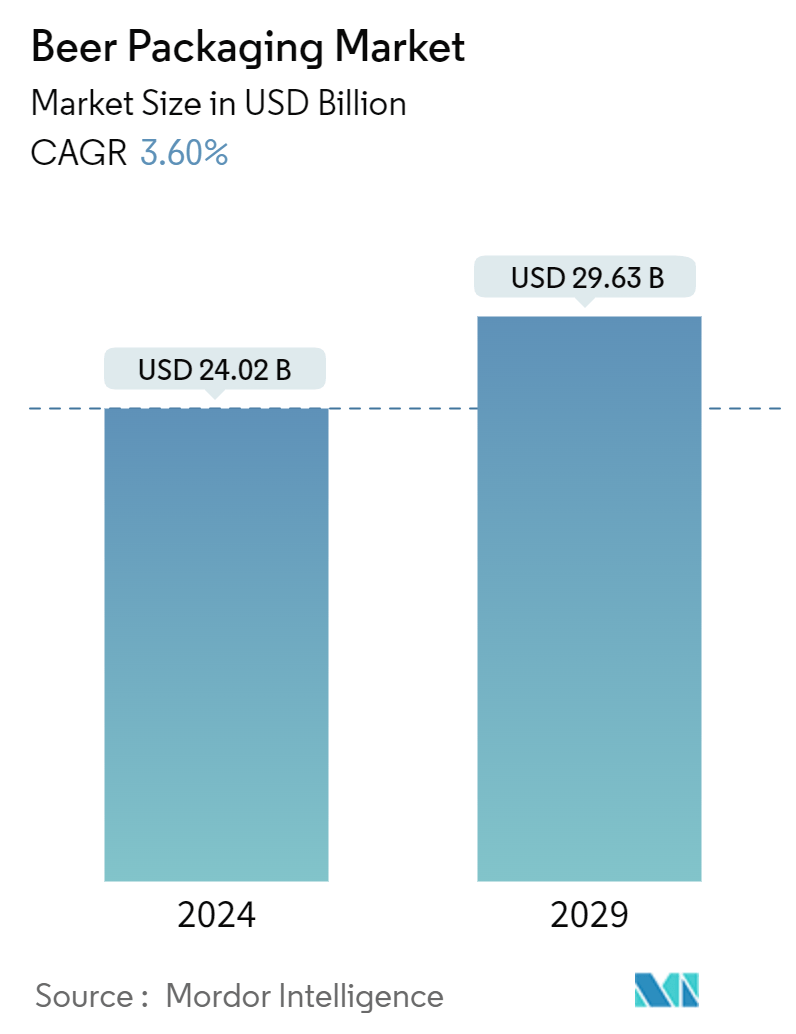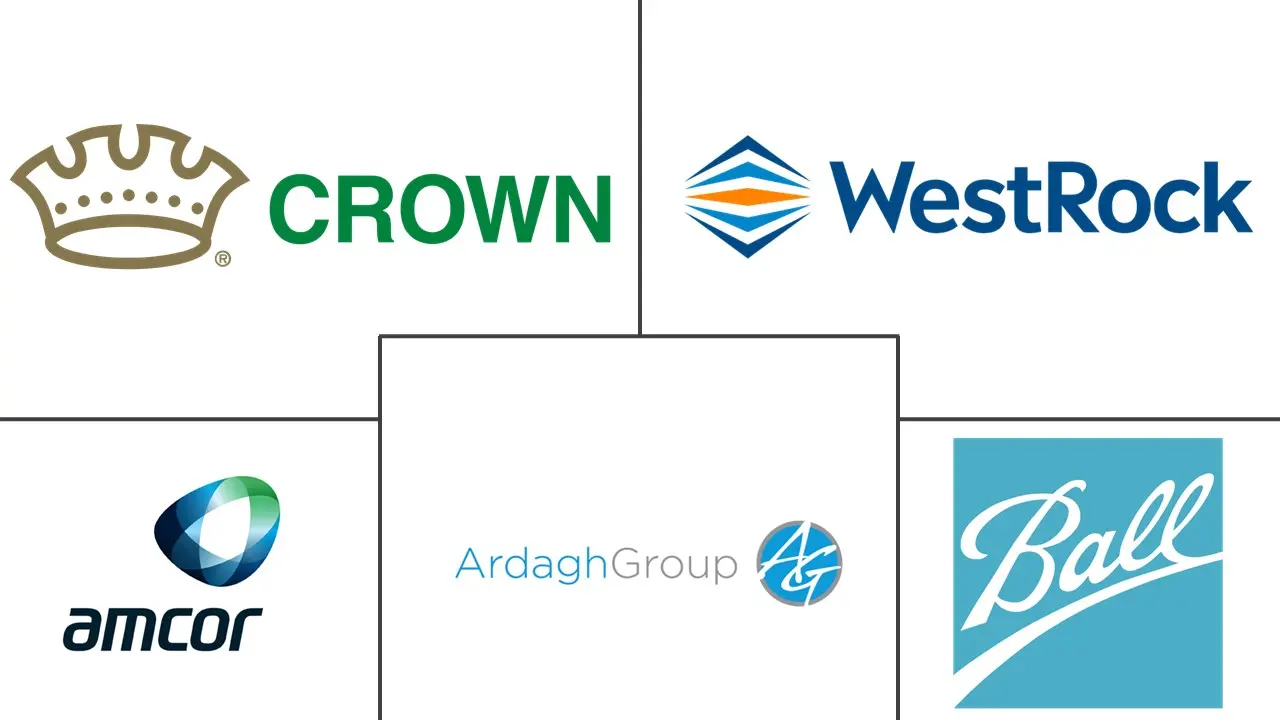Market Size of Beer Packaging Industry

| Study Period | 2019 - 2029 |
| Market Size (2024) | USD 24.02 Billion |
| Market Size (2029) | USD 29.63 Billion |
| CAGR (2024 - 2029) | 3.60 % |
| Fastest Growing Market | Asia Pacific |
| Largest Market | North America |
| Market Concentration | Low |
Major Players
*Disclaimer: Major Players sorted in no particular order |
Beer Packaging Market Analysis
The Beer Packaging Market size is estimated at USD 24.02 billion in 2024, and is expected to reach USD 29.63 billion by 2029, growing at a CAGR of 3.60% during the forecast period (2024-2029).
- Beer packaging encompasses the technologies employed in the packaging process. It represents a crucial aspect of beer production, accounting for a significant portion of the overall value of the process. In recent years, the beer packaging market has experienced a surge in popularity due to innovative packaging solutions, a trend anticipated to have a considerable effect on the market. Additionally, increasing investments aimed at enhancing beer manufacturing are likely to further propel market growth.
- The beer packaging market is closely linked to the beer manufacturing industry. Over the last ten years, shifts in lifestyle preferences and the growing accessibility of beer worldwide have led to a notable increase in the importance of beer packaging. The rising demand for different beer sizes and the convenience of single-use consumption have made beer an attractive choice for a diverse array of consumers, consequently propelling the expansion of the beer industry and boosting market growth.
- The increasing consumer preference for high-quality beer is a key factor contributing to the expansion of the market. Premium beer is often presented in more appealing and robust packaging. There is a growing trend among consumers to seek out beers crafted from superior ingredients and featuring distinctive flavor profiles. This trend is fueling the need for packaging solutions that not only safeguard the quality of premium beer but also convey its upscale image to potential buyers.
- A notable trend in the industrial sector has been the movement from bottles to cans. This transition can be attributed to the enhanced accessibility of small canning lines for craft brewers, evolving consumer preferences, and specific supply chain challenges. Additionally, the rising popularity of craft beer is fueling the demand for high-quality beer packaging. Craft beer is generally produced in limited quantities and frequently features distinctive flavor profiles. Furthermore, growing investments aimed at enhancing the production capabilities of craft beers are anticipated to further stimulate market growth.
- The increasing demand for craft beer across different areas is positively influencing the growth of the beer packaging market. Consumers are increasingly favoring craft beer produced by both small and large breweries. According to Kirin Holdings, China, the United States, and Brazil, recognized as the three foremost beer-consuming nations, collectively accounted for over 40% of global beer consumption. For example, within the US beer industry, valued at USD 116.9 billion, domestic beer held the largest share at 63.6%, followed by imported beer at 23.2%, and craft beer at 13.3% in 2023. Such factors are expected to drive the market.
- Moreover, a significant driver of market expansion is the emergence of premium beers presented in "smart packaging" and those that possess a "luxury" allure. Beyond smart packaging, there is a rising trend of resealable and collapsible or flat-pack packaging within the market, particularly in contexts where storage, retail dispensing, and transportation are critical, necessitating a proactive approach to meet the needs of outlets. Additionally, evolving style preferences and the growing affordability of beer globally are pivotal elements expected to boost the growth of the beer packaging market during the forecast period.
- Conversely, the growing consumer inclination toward wine may pose a challenge to the market. With the rising affordability of wine and other liquor products, this trend is anticipated to persist, leading to an increasing number of consumers gravitating toward these beverages. Modern consumers seek variety, quality, and authenticity, which compels winemakers to broaden their product lines and explore different grape varieties. These elements are likely to create challenges for the market.
Beer Packaging Industry Segmentation
Beer packaging is an extremely important process in the production, transport, and sale of this beverage. Beverages can be bottled in glass bottles, PET bottles, and cans.
The market is segmented by packaging material, packaging type, and geography. By packaging material, the market is segmented into glass, metal, and PET. By packaging type, the market is segmented into bottles, pegs, and cans. By geography, the market is divided into North America, Europe, Asia-Pacific, Latin America, and Middle East and Africa.
| By Packaging Material | |
| Glass | |
| Metal | |
| PET |
| By Packaging Type | |
| Bottle | |
| Keg | |
| Can |
| By Geography | ||||||
| ||||||
| ||||||
| ||||||
| ||||||
|
Beer Packaging Market Size Summary
The beer packaging market is experiencing a steady growth trajectory, driven by the increasing demand for innovative packaging solutions and the rising consumption of craft beer. This growth is closely tied to the beer manufacturing industry, which has seen a surge in popularity due to changing lifestyle trends and the growing affordability of beer worldwide. The market benefits from the versatility of beer packaging, catering to a diverse consumer base that prefers various sizes and types of beer. However, the market faces challenges from shifting consumer preferences towards wine and other liquor products, which could impact its growth. Despite these challenges, the demand for beer packaging continues to rise, supported by the expanding craft beer segment and the need for effective packaging solutions that preserve the quality and freshness of the product.
Glass packaging is expected to dominate the beer packaging market due to its numerous advantages, such as reusability and superior protection against spoilage and UV rays. The Asia-Pacific region is a significant driver of market growth, fueled by cultural shifts, urbanization, and the increasing popularity of beer among younger consumers. The region's expanding population and rising disposable incomes are contributing to the adoption of premium beers, further boosting the packaging market. The competitive landscape of the beer packaging market is characterized by the presence of both international and domestic manufacturers, with key players like Amcor Limited, Ardagh Group SA, and Ball Corporation leading the charge. Recent industry developments, such as Crown Holdings' acquisition of Signode Industrial Group and Carlsberg's launch of the Snap Pack, highlight the ongoing innovation and strategic moves within the market.
Beer Packaging Market Size - Table of Contents
-
1. MARKET DYNAMICS
-
1.1 Market Overview
-
1.2 Introduction to Market Drivers and Restraints
-
1.3 Market Drivers
-
1.3.1 Changing Consumer Preferences
-
1.3.2 Innovative Packaging and Attractive Marketing
-
-
1.4 Market Restraints
-
1.4.1 Consumer Preference of Wine and Liquor Over Beer in a Few Regions
-
-
1.5 Industry Value Chain Analysis
-
1.6 Industry Attractiveness - Porter's Five Forces Analysis
-
1.6.1 Threat of New Entrants
-
1.6.2 Bargaining Power of Buyers/Consumers
-
1.6.3 Bargaining Power of Suppliers
-
1.6.4 Threat of Substitute Products
-
1.6.5 Intensity of Competitive Rivalry
-
-
-
2. MARKET SEGMENTATION
-
2.1 By Packaging Material
-
2.1.1 Glass
-
2.1.2 Metal
-
2.1.3 PET
-
-
2.2 By Packaging Type
-
2.2.1 Bottle
-
2.2.2 Keg
-
2.2.3 Can
-
-
2.3 By Geography
-
2.3.1 North America
-
2.3.1.1 United States
-
2.3.1.2 Canada
-
-
2.3.2 Europe
-
2.3.2.1 United Kingdom
-
2.3.2.2 Germany
-
2.3.2.3 France
-
2.3.2.4 Rest of Europe
-
-
2.3.3 Asia-Pacific
-
2.3.3.1 China
-
2.3.3.2 India
-
2.3.3.3 Japan
-
2.3.3.4 Rest of Asia-Pacific
-
-
2.3.4 Latin America
-
2.3.4.1 Brazil
-
2.3.4.2 Mexico
-
2.3.4.3 Rest of Latin America
-
-
2.3.5 Middle East and Africa
-
2.3.5.1 Saudi Arabia
-
2.3.5.2 United Arab Emirates
-
2.3.5.3 South Africa
-
2.3.5.4 Rest of Middle East and Africa
-
-
-
Beer Packaging Market Size FAQs
How big is the Beer Packaging Market?
The Beer Packaging Market size is expected to reach USD 24.02 billion in 2024 and grow at a CAGR of 3.60% to reach USD 29.63 billion by 2029.
What is the current Beer Packaging Market size?
In 2024, the Beer Packaging Market size is expected to reach USD 24.02 billion.

